Living with Wildlife in Anchorage:
A Cooperative Planning Effort
Chapter 4: Wildlife in Anchorage, 1999
This chapter describes the state of Anchorage's wildlife in 1999. It begins with a list of wildlife issues, and describes prominent city wildlife species, including estimated and preferred population levels (standards). The chapter also provides information about residents' general attitudes toward wildlife. It concludes with a section on wildlife conflict statistics and standards that define acceptable levels of conflict.
|
Wildlife issues and concerns A summary of Anchorage's wildlife General values and attitudes toward Anchorage wildlife Wildlife conflict statistics and standards |
Wildlife Issues and Concerns
The following list summarizes issues and concerns developed by the planning team with input from the public. The items are meant to be evocative of the issues discussed at meetings, not exhaustive or comprehensive. They are organized within categories that roughly correspond to plan goals and objectives (see Chapter 3).Habitat and Population Level Issues
- Habitat fragmentation and loss due to increasing development
- Impacts (disturbance) to species from increasing human use on public land
- Loss of wetlands and wildlife corridors
- Wildlife habitat concerns that do not become integrated into land use decision-making (e.g., zoning, road improvement landscaping choices)
- Current development trends that favor exotic species (pigeons, starlings, etc.)
- Loss of critical habitat for some species (loons, cranes, other wetland species, etc.)
- Lack of wildlife-related inventory data (population trends, biological carrying capacity estimates, etc.)

Wildlife Recreation and Learning Issues
- High interest in and demand for viewing opportunities by residents and visitors
- Need for more wildlife education (facilities and interpretation services and materials)
- Demand for increased Anchorage hunting opportunities

Wildlife Conflict Prevention and Response Issues
- Lack of information about human/wildlife conflicts (When, where, why, how many, what kind?)
- Concern about the number of moose-vehicle accidents
- Concern about the number of aggressive moose encounters in neighborhoods and on trails
- Concern about the extent of landscaping damage by moose
- Concern about the number of and potential for bear-human encounters on area trails and in neighborhoods
- Increasing attraction behavior by bears in response to garbage, dog food, and birdseed around homes.
- Goose-aircraft accident risk
- Concern about the amount of goose droppings in parks, ball fields, lakes and on lawns
- Liability concerns regarding human/wildlife conflicts
- Agency responsibilities and jurisdictions for responding to wildlife-human conflicts
- Educating residents (especially new residents) on appropriate behavior around wildlife
- Lack of coordinated government/organizational programs to reduce wildlife conflicts
- Lack of training of public safety officials to deal with wildlife conflicts
- Conflicts between domestic animals/pets and wildlife
- Concern about landscaping that attracts wildlife and exacerbates conflicts (at schools, along roads)
- Concern that salmon fishery development may be attracting bears into the city
- Concern about other conflict problems: pigeons, gulls, beaver, coyotes, wolves, etc.

Other Issues
- Need to promote the benefits of wildlife in the city
- Lack of recognition of wildlife benefits within some government agencies
- Need to integrate wildlife agency decision-making among multiple agencies at local, state, and federal level
A Summary of Anchorage's Wildlife
This section describes the state of Anchorage's wildlife by species or group. For each major species or group, we attempt to provide population estimates and trends, as well as short descriptions of preferred habitat and management issues. When available, citations and sources for the information in this section are provided. In most cases, however, information is based on current (1999) professional judgments of biologists with the Alaska Department of Fish and Game. This information is not necessarily definitive, and is offered to provide readers with a general view of the wildlife situation in Anchorage. Actions in this plan are designed to address the lack of more comprehensive information for several species in the future.
This section also suggests population goals for several species, in an attempt to identify those that need to be enhanced or reduced. Establishing a population goal that is lower than current levels, however, does not necessitate any particular action. These population goals simply highlight the potential for increased wildlife conflicts or biological capacity problems. Additional discussion of population management policies and actions is given in Chapter 5.
Throughout this section, the “Anchorage area” refers to the entire Municipality from Knik River to Portage, including Chugach State Park. In contrast, the “Anchorage Bowl” refers to the land from the Chugach foothills to Cook Inlet, and from Potter Marsh to the military bases; it does not include Fort Richardson, Elmendorf Air Force Base, Chugach State Park, Eagle River/Chugiak/Peters Creek, or Turnagain Arm communities.
Readers should also note that fish and other aquatic species are not included within the scope of this plan (see Chapter One, Plan Limitations).
General Biodiversity. Overall, the Anchorage area supports 52 species of mammals, and at least 230 bird species (with about 150 bird species likely to be regular visitors or year-round residents) (Scher, 1993). That's about half of the bird species recorded in the whole state. Anchorage has one native amphibian species (the wood frog), and no reptiles. There are also a myriad of insect species and other invertebrates, few of which have been studied specifically in Anchorage.
Black Bears. An estimated 250 black bears live in the Anchorage area (between the Knik River and Portage), including Chugach State Park. Perhaps one-third of these bears spend at least part of the summer in or adjacent to residential areas in the Anchorage Bowl, Eagle River/Chugiak, or Girdwood. Black bears in Anchorage prefer forested habitat, including steam corridors. Judging by the number of cubs, the black bear population is probably increasing; this is further supported by the number of calls to ADF&G from residents, which have sharply increased in recent years. Black bears can easily become attracted to human food sources such as trash, pet food, and birdseed, making them potentially dangerous to humans and their pets or livestock (some Anchorage residents have rabbits, chickens, or other small livestock).
Brown Bears. About 60 brown bears live in the Anchorage area, and four or five are regularly seen in residential areas each summer (e.g., in the Anchorage Bowl or other developed areas such as Eagle River/Chugiak or Girdwood). However, subdivisions are expanding rapidly into bear habitat adjacent to Chugach State Park, particularly in Eagle River, along Hiland Road, and on the Hillside. Large lots and dense natural vegetation allow bears to use these subdivisions without being seen. Brown bears are generally likely to avoid humans and human environments, but can also learn to associate food opportunities (trash, fish offal, or small livestock) with people. They are also occasionally attracted to the Anchorage Bowl by winter-killed moose, abundant moose calves in spring, and spawning salmon in streams. Because of their size and potential aggressiveness, brown bear use of residential areas presents a definite human safety risk.
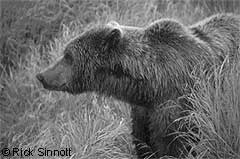
The number of both black and brown bears in the Anchorage area has increased in the last three decades, due to hunting restrictions and availability of human food sources. Black bear hunting was eliminated in the Eagle River valley, in the Anchorage Bowl (south of Tudor Road), and in adjacent portions of Chugach State Park in 1987. Black bear hunting in the rest of the Municipality allows only one black bear per hunter per year. Brown bear hunting has been prohibited in Chugach State Park and the Anchorage Bowl since 1973.
Moose. The moose population in and around Anchorage has remained high since the 1970s, with about 1,900 animals in the entire Municipality (including Chugach State Park) in 1998. In the Anchorage Bowl, moose are also abundant, with approximately 200-300 in the area year-round, and about 700-1,000 moose in the winter. The winter moose come from adjacent areas (Fort Richardson, Elmendorf Air Force Base, and the mountains east of town in Chugach State Park). In Anchorage, moose are concentrated in area parks, greenways and undeveloped open space, but may frequently visit suburban neighborhoods.
The Anchorage moose population is controlled primarily through starvation, vehicle collisions, some calf predation from bears and wolves, and limited hunts on the two military reservations. Despite this, moose populations appear to be rising again to the peak levels that were experienced in 1994. At that time, there were an estimated 2,100 moose in the Anchorage area and probably over 1,000 wintering moose in the Anchorage Bowl. This was followed by a sharp decline during the harsh winter of 1994-1995, when nearly a third died. In recent years, habitat in many areas also appears to have been over-browsed, particularly on Fort Richardson and in the Anchorage Bowl. From 1994 to 1999, an average of about 156 moose were killed in vehicle collisions in the entire Anchorage area each year, with the high year being 1994-95 (when there were 239 documented kills by collisions). About 100 moose are harvested annually in local hunts, most of which occur on the military reservations.

Moose are symbolically linked with Anchorage (the town mascot used by the Convention and Visitor's Bureau is a moose named “Seymour”), and they provide residents and visitors with exceptional viewing opportunities, especially in winter. However, they are also a hazard to drivers during the winter, and individual moose can become aggressive when under stress or protecting their young or territory. Certain human behaviors toward moose (e.g., people who feed them, individuals who harass them with snowballs) can exacerbate human-moose interactions, with damaging results. People have been stomped to death by moose in Anchorage (in 1993 and 1995), as many as 50 to 100 dogs are injured (some killed) annually, and cross country skiers and dog mushing teams using city trails have been charged on numerous occasions. There is concern among some trail users (particularly dog mushers) that moose are becoming more aggressive toward humans in the past decade. ADF&G has to destroy some individual aggressive moose each year.
Dall Sheep. Sheep are numerous in Chugach State Park (which has an estimated population of 2,400), and dozens of sheep can be seen on the hillsides above the Anchorage Bowl. Sheep generally live in the steep, rocky alpine terrain of the Chugach Mountains, but will visit lower elevations to access mineral deposits. One mineral lick, at Windy Point on the Seward Highway, has become a popular sheep viewing area, but traffic congestion at this relatively undeveloped site affects the quality and safety of viewing opportunities. Planned highway and viewing facility improvements (as advocated in the actions section of this plan) are likely to address some of these problems. Sheep populations in the park and at the Windy Point viewing area appear to be stable.

Mountain Goats. In addition to Dall sheep, there are also an estimated 200 mountain goats in the mountains of Chugach State Park, with over 500 more goats in portions of the Municipality east of the Park. Mountain goats live in steep alpine terrain, and are less likely to be seen along roads or on the slopes above the Anchorage Bowl. The goat population appears to be increasing slowly.
Beaver. The number of beavers in the entire Municipality is unknown, but there are an estimated 150 in the Anchorage Bowl. Beavers live along area streams, which are largely within publicly-owned parklands and greenbelts or on the military bases. Beaver activity provides important benefits to salmon and water quality. Their ponds create rearing and overwintering habitat for juvenile salmon; provide invertebrates, trapped organics, and other nutrient input including spawned-out salmon carcasses essential to the food web of the stream; and help water quality by allowing fine sediments to settle out. Large woody debris and ponds add complexity to a stream, which is vital to healthy fish habitat. Beavers occasionally cause damage on developed or private lands by cutting down trees or building dams that cause flooding. The beaver population in Anchorage appears to be stable.
Wolves. There are four or five packs (a total of 25-30 wolves) in the Anchorage Municipality, and two packs active in the Anchorage Bowl (about 12 wolves total). Wolves can inhabit a wide variety of terrain, and may have huge territories. In Anchorage, wolves appear to be relatively adept at avoiding humans, but may still be involved in some conflict situations. For example, wolves appear to kill up to about five dogs each year in the Anchorage area (although most of these dogs are found to have been running free). Wolf populations in Anchorage appear to be stable at this time.
Other Furbearers and Small Mammals. A variety of other furbearers are present in the Municipality of Anchorage, including wolverine, coyote, lynx, snowshoe hare, red fox, mink, weasel, and marten. Other small mammals include porcupine, red squirrels, northern flying squirrels, hoary marmot, little brown bat, and mice, voles, and shrews. (See Appendix C for complete list of mammals.)
Coyote and red fox numbers are unknown, but they appear to be stable or increasing, based on sightings. Lynx populations fluctuate in cycles with snowshoe hare populations, and appear to number 15-20 in the Anchorage Bowl in 1999. Lynx sightings in Chugach State Park appear to be increasing in the past two years. There is generally little trapping of these species in the Anchorage area.
Feral Rabbits. There are probably hundreds of feral rabbits in the Anchorage Bowl, all descended from tame rabbits released by humans. Adept at surviving in urban and suburban environments, they appear to be increasing. They are currently not a threat to native snowshoe hares through competition or interbreeding. (Snowshoe hares number in the thousands and also appear to be stable within a cyclic population range.) However, feral rabbits may transmit diseases, they do compete with snowshoe hares, and they can create property damage with their burrows and feeding habits.
Loons. Anchorage is the largest city in North America with nesting loons, and up to thirteen pairs of loons attempt to nest each year on city lakes (Fair, 1998). This includes up to seven pairs of Pacific loons (most on lakes in the Anchorage Bowl) and up to six pairs of common loons (most on lakes on the two military reservations). Although there are 45 lakes of suitable size for loon nesting, only about fourteen lakes have been actively used by loons since 1994. In the period from 1982-1994, twenty-one different lakes were used by at least one pair in one year. Since 1994, an average of 4.8 nesting pairs of common loons have fledged an average of 5.5 chicks annually, while an average of 4.5 pairs of Pacific loons have fledged an average of 2.0 chicks annually. The Pacific loon reproductive rate is lower than necessary to sustain the local population (an estimated 0.5 chicks per pair per year is required). Both of these breeding populations are vulnerable to local extirpation because of their low current numbers and geographic isolation from other loon populations. Both of these species have been identified by the planning team as needing greater protection and management attention to prevent future population losses.
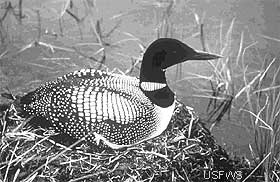
This is a common loon. Pacific loons, with gray head and bright throat patch, also nest in Anchorage.
Grebes. Anchorage lakes also support breeding populations of both red-necked and horned grebes, although the latter are much less common or prolific in this area. Like loons, horned grebes appear to be more sensitive to human disturbance while nesting, and population stability may require habitat conservation or enhancement efforts.
Cranes. Sandhill cranes nest and raise young along the coast and in remaining large, open wetland areas. They can be sensitive to disturbance during nesting and migration. Crane populations in Anchorage appear to be stable at this time, but have probably declined from mid-century when development levels were lower and there were more extensive wetlands.
Canada Geese. Geese began nesting in Anchorage in the early 1960s and were not reported here before that time. There are several subspecies of Canada geese. Most Anchorage geese are lesser Canada geese. Geese both feed and stage in Anchorage, and prefer habitat that features available grass adjacent to open water. Summer goose population levels have grown to about 4,600, and they are increasing at about 6% per year even as wildlife authorities have attempted to check increases through an egg collection and gosling translocation program. Geese are a significant threat to aircraft (an Air Force plane crashed in 1995 after colliding with a flock of geese and 24 people were killed), and local air fields all have active harassment programs designed to keep geese from those areas. Geese can also become a nuisance around lakes and at parks, ball fields, and golf courses. Their feces make areas unattractive to many people and may contribute to the dispersion of a parasite that causes swimmer's itch. Chapter 5 contains a section summarizing the extensive management efforts associated with this species.
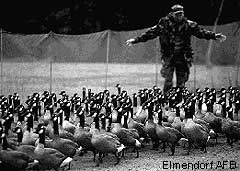
Mallards and Other Waterfowl. Like Canada geese, mallards and some other waterfowl species have increased in the Anchorage area in recent years. Based on the Audubon Society's Christmas Bird Count (CBC), about 3,000 mallards now remain in the Anchorage area each winter. Most of these live in the Bowl, and are attracted by human hand-outs and open water. The mallard population is generally increasing, but may have dropped for a year or two after a 1996 road reconstruction reduced the amount of open water near the Spenard Road side of Westchester Lagoon. In more recent years, population numbers have returned to about 3,000 birds in winter. This high mallard population contributes to the nuisance problems identified with geese.
Waterfowl are attracted to the area's lakes, streams, and wetlands, but the wetlands have significantly decreased since the 1950s. Ducks and geese are hunted in the Anchorage Coastal Wildlife Refuge, with about 1,000 harvested annually.
Other waterfowl that migrate through Anchorage include swans, northern pintail, goldeneyes, mergansers, green-winged teal, bufflehead, scaups, and several other duck species. Additional information about waterfowl species and their abundance is needed for Anchorage, and actions in this plan are designed to increase our knowledge.
Shorebirds. Forty species of shorebirds have been recorded in the Municipality (Scher, 1993), but only ten (including common snipe, lesser yellowlegs, short-billed dowitcher, least sandpiper, semipalmated plover, and spotted sandpiper) appear to regularly nest in the Anchorage Bowl. Other species, including Hudsonian godwits, may occasionally breed in the area (C. Maack, personal communication, 1999). Because considerable wetlands in the Bowl have been drained since 1950, breeding populations of these water birds have probably also declined (L. Tibbitts, personal communication, 1999). Retention of remaining wetlands within the Bowl will help ensure persistence of breeding species; protection of nesting areas from human disturbance may also be important and is addressed through recommended actions in this plan.
Many other shorebirds depend on the wetlands and upper Cook Inlet mudflats during spring and fall migration. Species that migrate through in high numbers include short-billed dowitchers, Hudsonian godwits, greater and lesser yellowlegs, and least and pectoral sandpipers. In general, population levels of migrants seem to be stable at this time but protection of tidal areas remains critical (L. Tibbitts, personal communication, 1999; B. Andres, personal communication, 1999).
Gulls and Terns. Eighteen species of gulls and terns have been recorded in the Municipality (Scher 1993). During the last two decades, numbers of glaucous-winged and herring gulls increased dramatically, overtaking numbers of the smaller mew gull which was formerly the most common gull in Anchorage. Retention of wetlands within the Bowl, particularly the Anchorage Coastal Wildlife Refuge, can help maintain populations of other species, such as Arctic tern, which are less adaptable to urban environments.

Protection of remaining wetlands is critical to maintain these and other birds, such as shorebirds and less common gull species.
Glaucous-winged and herring gulls adapted easily to the increase in human garbage available in Anchorage, and are commonly seen at dumpsters. Although population surveys have not been conducted, biologists have counted more than 100 ground nests on a single empty lot in midtown Anchorage each spring. Large gulls become nuisances by vigorously defending nests on roofs and other structures, destroying roofing, fouling water, spreading avian diseases, and increasing nest predation on other birds. In 1999 natural resource agencies received more calls complaining about gulls than about any other birds. The USDA Wildlife Services program had contracts with 10 local businesses to remove gull nests where aggressive gulls threatened human safety, and the Municipality removed gull nests from several problem areas. Elimination of waterfowl feeding, and better attention to covering dumpsters, might help reduce the numbers and problems associated with large gulls.
Bald Eagles. There are probably dozens of bald eagles resident in the Municipality, and there are at least 9 nesting pairs in the Anchorage Bowl, with higher population numbers in winter. Eagles generally live and feed along streams, lakes, or the coast, but eagles occasionally scavenge human trash in Anchorage, particularly in winter. The eagle population in Anchorage appears to be stable or increasingly slightly.
Hawks. Thirteen species of hawks have been recorded in the Anchorage Bowl (Scher 1993). Although quantitative data are not available on population trends for these species, forest-dwelling birds, including sharp-shinned hawk, northern goshawk, red-tailed hawk and merlin, have likely declined due to forest fragmentation caused by urban development. Populations of alpine-breeding species such as golden eagle, northern harrier and gyrfalcon have probably remained unchanged, because their habitat has not been altered by human development.
Owls. Seven species of owls have been recorded in the Anchorage Bowl (Scher 1993). Resident species include the forest-dwelling great horned owl, boreal owl, and northern saw-whet owl. Boreal owls have likely declined as forests have been cut for development during the past three decades. Forest loss may not have affected great horned owls as much, because they use forest openings, which may actually increase as forests are fragmented. The Anchorage population status of the little saw-whet owl is uncertain, and is currently under study (B. Dittrick, personal communication, 1999). Snowy owls, great gray owls, northern hawk owls and short-eared owls reside in the area in winter or during migration, although northern hawk owls may also occasionally nest in the Municipality.
Migratory Songbirds and Other Small Land Birds. Anchorage supports year-round resident songbirds as well as many migratory species that arrive in the spring to breed. Other species occur here occasionally. Over 90 species of land birds have been recorded in the Anchorage Bowl (see Appendix C for list of most common species). About 58 species, including the 29 year-round resident species, breed here (Scher, 1993). This group includes families such as kingfishers, woodpeckers, flycatchers, jays and ravens, swallows, chickadees, thrushes, warblers, sparrows and finches.
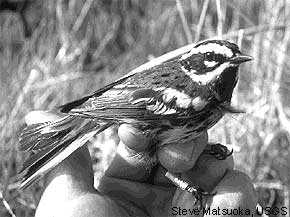
This banded bird is part of a study to determine effects of the recent bark beetle infestation on this spruce-dependent species.
The Christmas Bird Count suggests that 40 to 50 bird species (not all of them songbirds) are regularly seen in winter. The most common land birds recorded in winter are rock dove (pigeon), black-billed magpie, raven, black-capped chickadee, red-breasted nuthatch, Bohemian waxwing, pine grosbeak, redpoll, and six species of sparrow. Grouse and ptarmigan species are local resident land birds more commonly found in less developed forested and alpine areas of the Municipality.
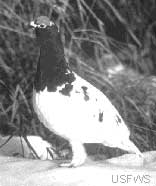
Collection of quantitative data on population changes in songbirds and their allies has only recently begun. However, loss and fragmentation of forests and wetlands within the Anchorage Bowl have likely reduced breeding populations of some species. Many species require larger tracts for sufficient foraging or nesting habitat. Retention of large tracts of remaining spruce-birch forest and wetlands would benefit numerous songbird and raptor species. Retention of forested corridors which connect smaller tracts would help these tracts function as larger tracts, and also facilitate the dispersal of young birds.
Another habitat factor that has significant effects on biological diversity (numbers of species) and population sizes is the vertical structure of the forest. When the understory (shrubs and other plants growing naturally under the forest canopy) is removed, many birds lose nesting, foraging, and protective habitat. The problem of protective understory loss is made worse by the increase in free-roaming domestic cats as the city grows. Cats are efficient songbird predators; biologists estimate that cats kill hundreds of millions of birds each year in the United States alone.
Biologists and birders have recently noticed several interesting changes in bird populations. Although they remain relatively uncommon, populations of downy, three-toed, and black-backed woodpeckers appear to have recently increased as a result of the spruce bark-beetle outbreak in the late 1990s (B. Andres, personal communication, 1999). In contrast, other songbird species (e.g., Townsend's warbler, ruby-crowned kinglet) have probably lost habitat as a result of the outbreak. The long-term effects of the spruce bark-beetle infestation on these and other bird species are still unknown. Recent outbreaks of bill deformities in black-capped chickadees and avian salmonella in redpolls and pine siskins have been noted, but the causes are presently unknown.
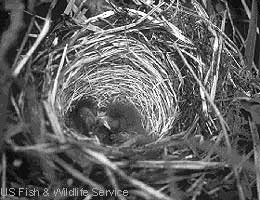
Ground-nesting species are particularly vulnerable to free-roaming pets and to the common landscaping practice of removing the protective forest understory.
Ravens. There are probably over 1,000 ravens in the Anchorage Bowl in winter and the population seems stable. There is a noticeable seasonal movement of these birds, with only about 200 birds resident in summer. Ravens are intelligent birds with the ability to live in a variety of environments, and are adept at scavenging human food. This can occasionally create conflicts with humans who do not secure their trash.
Rock Doves (non-native). The rock dove or pigeon is an exotic species that may number over 2,000 in the Municipality, with about half that number in the Anchorage Bowl. This population is growing, and they may be out-competing several other native bird species, or harboring diseases such as avian salmonella that affect other birds or people. Pigeons are all descended from tame birds that were released, and can successfully live in urban environments, especially when people feed them. One positive consequence of rock dove populations in Anchorage is that they may be attracting avian predators (e.g., gyrfalcon, which have been regularly observed since rock doves arrived in the city).
European Starlings (non-native). This is another exotic species that has spread across North America since its introduction from Europe in the 1890s. Starlings arrived in Anchorage in the last decade and are now year-round residents in the Bowl. The starling population in Anchorage is unknown and appears to be small but growing. They are a concern to biologists because starlings aggressively compete with cavity nesters such as woodpeckers and chickadees, their large roosts in buildings and trees can create noise and odor nuisances, and their droppings may allow a soil fungus to spread histoplasmosis, which humans can contract. Pests in many lower-48 communities, once their populations have been established they have proven nearly impossible to control.
Invertebrates. In addition to birds, mammals, fish, and wood frogs, there are thousands of invertebrate species in Anchorage, each with roles in the larger ecosystem. While it is beyond the scope of the current plan to identify and discuss conservation issues with regard to these species, the planning team would like to recognize their importance.
Of particular concern are aquatic insects such as stoneflies, mayflies, caddisflies, blackflies, craneflies, and midgeflies, all of which are present in the city's streams. They are essential to the fish and wildlife food web, and may be good indicator species for water quality because they are sensitive to pollution. Similarly, dragonflies and damselflies are prominent species around lakes, ponds, and other freshwater wetlands. Mosquitoes, of course, are another important insect species in the ecosystem, despite their obvious nuisance qualities to humans and their pets. As the city has become more developed and both wetlands and heavy brush decrease, it is likely that certain insect species such as mosquitoes have decreased.
Summary of some major Anchorage mammal species
Table 1. Summary of some major Anchorage mammal species. (Note: See text for a discussion of sources.)
| Species | Population | Trend | Population Goal | |
|---|---|---|---|---|
| Summer | Winter | |||
| Black bear | ~250 in Municipality
~30 to 50 in Anchorage Bowl |
Stable or increasing | Maintain population; encourage avoidance behavior. | |
| Brown bear | ~60 in Municipality
~5 in Anchorage Bowl |
Stable | Maintain population; encourage avoidance behavior. | |
| Moose | ~1,900 in Municipality
~200-300 in Bowl |
~700 to 1,000 in Anchorage Bowl | Fluctuating; limited by available forage | Possibly reduce (see discussion in Chapter 5) |
| Dall sheep | ~2,400 in Municipality | Stable | Maintain population in park and at Windy Corner area. | |
| Mountain goat | 750 in Municipality | Stable | Maintain population. | |
| Beaver | ~150 in Anchorage Bowl | Stable | Maintain population. | |
| Wolf | 4 to 5 packs in Municipality (~25-30 wolves)
2 packs in Anchorage Bowl (~12 wolves) |
Stable | Maintain population. | |
| Red fox | Unknown | Stable or increasing | Maintain population. | |
| Coyote | Unknown | Stable | Maintain population. | |
| Lynx | Unknown | Cyclic | Maintain population range. | |
| Snowshoe hare | Unknown | Cyclic | Maintain population range. | |
| Feral rabbit | Hundreds in Anchorage Bowl | Increasing | Reduce or eliminate population. | |
Summary of some major Anchorage bird species or families
Table 2. Summary of some major Anchorage bird species or families.
(Note: See text for sources.)
| Species/ group |
Population | Trend | Population Goal | |
|---|---|---|---|---|
| Summer | Winter | |||
| Common loon | Max. of 6 pairs | 0 | Stable | Enhance/protect population due to its small size. |
| Pacific loon | Max. of 7 pairs | 0 | Declining | Enhance/protect population due to its small size |
| Sandhill crane | Unknown | 0 | Stable | Maintain population. |
| Canada goose | ~4,600 in Bowl | 0 | Increasing | Reduce existing population, and maintain at 2,000 in Anchorage Bowl. |
| Mallard | Unknown | ~3,000 in Bowl | Increasing | Maintain population at current levels. |
| Shorebirds | Unknown | 0 | Stable in recent years. | Maintain populations. |
| Gulls | Unknown | Unknown | Some increases; some stable |
Maintain populations. |
| Arctic tern | Unknown | Unknown | Unknown | Maintain population. |
| Bald eagle | Dozens in Bowl | Stable or increasing | Maintain population. | |
| Hawks | Unknown | Unknown | Stable in recent years. | Maintain populations. |
| Rock dove (pigeon) | >2,000 in Bowl | Increasing | Reduce or eliminate population. | |
| Owls | Unknown | Unknown | Stable in recent years. | Maintain populations. |
| Migratory songbirds & other small land birds | Unknown | Unknown | Some species stable in recent years; others unknown | Maintain populations. |
| Common Raven | <200 in Bowl | >1,000 in Bowl | Stable | Maintain population. |
| European Starling | Unknown | Unknown | Increasing | Reduce or eliminate population. |
General Values and Attitudes toward Anchorage Wildlife
This section provides a sample of information from the 1997 study of Anchorage residents' attitudes toward wildlife and wildlife issues. It is useful for characterizing current wildlife interest levels and general values toward wildlife. Readers interested in more information about the survey findings are referred to the summary report (Whittaker and Manfredo, 1997), available from the Alaska Department of Fish and Game.
Wildlife Recreation Participation
Anchorage residents appear to be highly interested in wildlife recreation. Well over one-third (39%) report they have taken trips explicitly to view wildlife, and very high majorities report having enjoyed watching moose (96%) and geese (92%) in Anchorage. Over one-quarter of residents also report having fed geese, suggesting a significant minority of residents feel a strong affiliation with this species. Almost half of the residents surveyed also reported past or current participation in hunting. Over one quarter (28%) reported being current hunters, while another 20% reported they have hunted in the past.
Basic Wildlife Beliefs
People's attitudes toward wildlife species, problems, and management actions are thought to be influenced by their beliefs and values toward wildlife in general. The survey asked people about 29 statements that reflect eight different “basic wildlife beliefs.” Combining results into eight scales reveals general patterns of attitudes toward wildlife, as shown below and discussed on the following page. (Note: “neutral” responses are not shown).
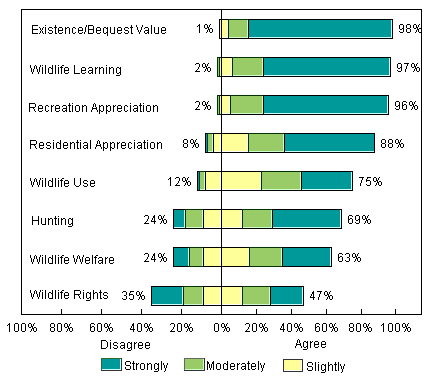
Wildlife Existence/Bequest Value Beliefs. Four questions measured existence and bequest value of wildlife. Existence questions focused on the importance of maintaining wildlife populations even if people don't see them, while bequest questions focused on maintaining wildlife populations for future generations. Almost all residents agreed with these types of statements.
Wildlife Learning. Three questions measured wildlife learning beliefs, focusing on whether residents enjoy learning about wildlife and whether they think wildlife learning is important. Almost all residents agreed with these statements, although there was variation in their strength.
Appreciation in Recreation Settings. Three questions measured residents' appreciation for wildlife in recreation settings, focusing on whether people enjoy watching wildlife on trips, or whether wildlife is an important reason for taking trips. Almost all residents agreed with these statements, although there was variation in their strength.
Appreciation in Residential Settings. Four questions measured appreciation for wildlife in residential settings, focusing on whether people enjoy watching wildlife around their homes and whether they are interested in attracting wildlife to their neighborhoods. Most residents agreed with these statements, but to a slightly lesser degree than for other “appreciation” beliefs.
Wildlife Use. Four questions measured wildlife use beliefs, focusing on whether wildlife populations should be managed for human benefit and whether it is acceptable for wildlife use to cause the loss of individual animals as long as populations are not threatened. A majority (75%) of residents hold pro-use beliefs, indicating general interest in a wildlife stewardship ethic.
Hunting. Six questions explored hunting beliefs, focusing on whether it is considered safe, humane, and whether it helps hunters appreciate wildlife and natural processes. Taken together, a majority of residents agree with pro-hunting beliefs while less than a quarter hold anti-hunting beliefs.
Wildlife Welfare. Two questions measured wildlife welfare beliefs, focusing on whether people should minimize wildlife pain and suffering if it is caused by human activities. A majority of residents generally agreed with a welfare position, indicating concern about the humane treatment of animals.
Wildlife Rights. Three questions measured whether human needs were more important than wildlife rights, or whether human and wildlife rights were equally important. While more people agree than disagree with wildlife rights, there was greater polarization over these beliefs.
Summary. Overall, these results suggest two general conclusions. First, very large majorities of Anchorage residents show appreciation for wildlife. They are interested in learning about them, seeing them during outdoor recreation and around their homes, and conserving them for future generations.
Second, while most residents hold use-oriented beliefs, a majority also agrees with some wildlife welfare or rights positions. This may seem initially inconsistent, but could simply reflect complexity among peoples' beliefs. For example, it is possible to be both pro-use and pro-welfare; many hunters are concerned with the humane treatment of wildlife even during harvest.
Pride in Anchorage's Wildlife
The survey also asked respondents to agree or disagree with five statements relating to “wildlife place-identity,” the extent to which people symbolically link wildlife with Anchorage's quality of life and a sense of place. Results are given in the following figure (showing the percent that slightly, moderately, and strongly agreed/disagreed with each).

Results suggest that a majority of Anchorage residents take pride in the city's wildlife, even if these animals cause some problems. For many residents, it appears that wildlife problems actually enhance the quality of life in the city because they make it seem “interesting and special.” A large majority also agreed that “people who live in Anchorage should learn to live with some conflicts or problems with wildlife,” although a smaller majority thought that the possibility of encountering brown bears was a positive aspect of Anchorage life.
Summary
On balance, these survey results show Anchorage residents to be highly appreciative of wildlife, as well as relatively tolerant of wildlife problems in the city. Results also suggest that a majority of residents support the use and management of wildlife species, while also showing concern that uses and management activities are conducted in humane ways and without threatening long-term population levels. The planning team considered these general values and attitudes throughout the planning process. More specific survey results were also considered when choosing among actions, and are presented in this plan where relevant.
Wildlife Conflict Statistics and Standards
Wildlife in Anchorage do cause some problems, and while most residents seem willing to tolerate existing levels, many are concerned about any increase in conflicts. This section provides some information on current wildlife conflict levels in Anchorage, and develops initial “standards” that define the point at which levels go from being acceptable to being unacceptable.
Exceeding these standards does not require any particular action, but they are seen as the “alarms” that signify a problem in need of increased attention. In general, the standards are set to reflect the acceptability of current conditions, but they also suggest the need to avoid any substantial increase.
Public comments during the draft planning stage suggest that some people prefer standards at levels significantly lower than current levels, particularly those related to black bears. The planning team accordingly revised bear-conflict standards to reflect conditions in 1997 rather than those in 1999.
Because conflict levels can fluctuate in any given year, these standards are not intended to be rigid and inflexible (i.e., a large increase in any single year because of aberrant weather or other factors may not be cause for over-concern). However, they suggest serious intent to maintain levels at or below the standards over time.
We also recognize that some of these conflict variables may be susceptible to manipulation by individuals or groups who have a strategic interest in demonstrating a conflict problem. People who favor the dramatic reduction of moose populations, for example, could conceivably lodge complaint calls about encounters with aggressive moose that never happened. While we do not think such manipulations are likely, we want the plan to explicitly recognize the potential. There are weaknesses in using some of these standards to decide when there is a conflict problem in Anchorage. However, until more systematic information about conflicts (and people's tolerances for them) can be developed, we feel these offer useful, measurable ways to assess how much conflict is occurring.
Finally, the standards also do not imply that it is desirable to have a certain level of conflicts; the obvious goal is to have as few as possible. However, with a city of 260,000 people and abundant wildlife, standards set at zero are unrealistic.
Several actions described in Chapters 5 and 6 of this plan offers ways to address wildlife conflict prevention and responses. In this section, we are simply identifying information that helps define when we have a problem.
Moose-Vehicle Accidents
An average of 156 moose were killed in moose-vehicle collisions each year in the Anchorage Bowl from 1994 to 1999. The record was in the winter of 1994-1995, when 239 moose were killed. However, there are probably many other collisions that only injure moose, or accidents and near-accidents that are caused by people attempting to miss a moose. This compares with about 9,000 total vehicle accidents in Anchorage each year. In a study in rural Alaskan areas (Thomas, 1995), moose collision damage averaged $15,100 (including repairs, insurance, medical costs, and lost wages). In this same study, most accidents were shown to occur during dark hours (by a 3:1 ratio).
Standard:
- Less than 150 moose-vehicle accidents in the Anchorage Bowl resulting in a moose death per year over any three-year period.

Moose Encounters
The Alaska Department of Fish and Game receives an estimated 1,000 calls per year about nuisance or aggressive moose in Anchorage. More than 100 people are charged each year by moose. Many of these are “bluff” charges that do not result in any physical contact between the moose and person. However, all of these are potentially serious, and 5 to 10 are estimated to result in human injuries each year. Since 1993, two people have been killed by moose. In addition, it is estimated that as many as 50 to 100 dogs are injured by moose each year, including those along trails designated for sled-dog racing. On average, about 10 aggressive moose are killed by wildlife authorities each year.
Standards:
- Less than 1,000 calls per year about nuisance or aggressive moose (until an improved system can monitor actual incidents of various types; actions in Chapter 6 address this issue).
- Less than 10 human injuries from moose charges per year.
- Less than 10 aggressive moose killed by wildlife authorities or in defense of life each year.
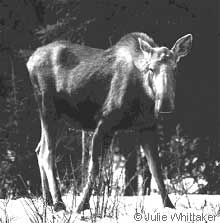
Moose Property Damage
Moose eat ornamental trees, shrubs, and gardens throughout the year. Damage estimates are in the hundreds of thousands of dollars, but no statistics are available. Landowners are expected to find their own means to protect their property from this damage (usually an 8-foot high or electrified fence is required). Accordingly, we have not established a standard for the amount of acceptable moose property damage. Note: Even without a standard, the plan has actions designed to help landowners protect themselves from this damage.
Black Bear Encounters
Black bears are attracted to residential areas because of natural foods as well as available human garbage, pet food, and birdseed. In the past several years, ADF&G received 300 to 400 calls about nuisance bears per summer. In 1998, however, this rose sharply to about 1,500 calls, and in 1999 the number of calls remained high.
Black bears may kill pets (although no accurate statistics are available) and occasionally injure people, but there has never been a reported human fatality from a black bear in Anchorage. By comparison, there are 600 reported dog attacks (on humans) in Anchorage each year.
From 1995-1998, between 9 and 16 black bears have been shot per year in defense of life or property, or by law enforcement or wildlife authorities for public safety. This is up from the years 1990 through 1994, when this number averaged only about 3 black bears dispatched per year.
Standards:
- Less than 300 calls per year about nuisance or aggressive black bears.
- No injuries to humans by black bears in any year.
- Less than 5 black bears killed in defense of life/property or by wildlife authorities on average each year.
In recent years, calls about aggressive black bears have increased dramatically, and the number of bears killed by residents and wildlife authorities has also increased. Standards recognize that current conflict conditions are unacceptable and should be reduced.
Brown Bear Encounters
Brown bears are also occasionally attracted into residential areas because of natural foods as well as available human garbage, pet food, and discarded fish offal. In the past several years, ADF&G received about 50 calls about nuisance brown bears each year. Brown bears are particularly dangerous animals, and occasionally attack livestock or pets, or chase bikers or joggers on city trails. Two people were killed by a brown bear in Chugach State Park in 1996, and a brown bear injures someone in Anchorage about every two to three years. In recent years, between one and three brown bears have been shot per year by residents (in defense of life or property), or by wildlife authorities (for public safety).
Standards:
- Less than 50 calls per year about nuisance or aggressive brown bears in the Anchorage Bowl.
- No injuries to humans by brown bears in any year.
- No more than 1 brown bear killed in defense of life/property or by wildlife authorities on average each year.
Canada Geese Aircraft Strikes and Property Damage
Canada geese are a significant hazard for aircraft and can damage the aesthetic appeal of lakes, lawns, ball fields, and golf courses.
An active and more detailed plan to address these problems has been developed by the Anchorage Waterfowl Working Group, so no standards are developed for these conflicts here. For a summary of the geese management efforts being led by this group, refer to Chapter 5.
